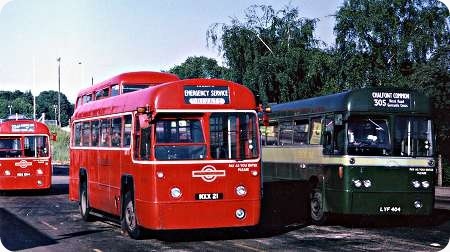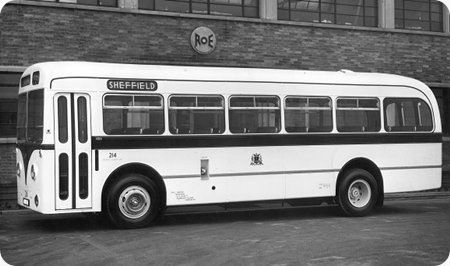London Transport – AEC Regal IV – MXX 21 – RF 379
London Transport
AEC Regal IV
MCW B41F
There were always a few places around London where red and green buses were seen together and this photo was taken at Uxbridge in 1974. Green RF 53 registration LYF 404 was a former Green Line vehicle, as shown by the twin headlights. Alongside is RF 379 registration MXX 21 whilst in the background is RF 406 registration MXX 294, which has survived into preservation. The RML hiding behind is probably about to start the long journey to Shepards Bush on the 207.
Photograph and Copy contributed by Tony Martin
17/10/13 – 006:57
Do we have a date(s) on these? I would guess 1953, but the twin headlamps didn’t come into vogue until later?
Joe
17/10/13 – 08:40
RF 53 wasn’t modernised into the form shown until 1967, so the picture must postdate that year.
Roger Cox
17/10/13 – 11:42
What would the emergency service be? Underground replacement, perhaps?
Geoff Kerr
18/10/13 – 17:10
My favourite, and the best, AEC single decker until the 6U3ZR Reliance. They accepted mid-life refurbishment and still exist in preservation 60 years on. [I know all of Rogers arguments about too many LTE buses in preservation, and LT practises – and I don’t necessarily disagree – but lets be happy that these gems survive even if we regret the passing of other types without the benefit of the preservation movement.]
David Oldfield
19/10/13 – 17:31
Tony’s caption says the photo was taken at Uxbridge, in 1974.
Pete Davies
19/10/13 – 17:32
The Uxbridge single deck routes lost their RF buses in favour of higher capacity double deckers in 1961-63, after the low bridge at West Drayton was modified. These routes got RFs back (in "one man operated" mode, which these seem to be) in January 1971.
Far more on red RFs at www.red-rf.com
The destination display "Railway Emergency Service" was used on LT blinds until the 1970s when it was changed to "Special Railway Service" – this tended to be used for both planned and emergency rail closures.
I’m not sure we should read too much into it being shown here – it’s possible that someone had just not wound the blind far enough to show the full ‘Private’ display. The old Uxbridge garage was up the Denham Road, this bus may have been a substitute for a service bus, or being used for crew shuttle purposes.
Jon
31/12/13 – 07:20
I moved from London to Aylesbury Bucks in 1965 about 1972 my young son became a cub with our local group one day I was asked if I would like to come and see their ex London bus I said no thanks but after a few times I agreed being an ex London bus driver. When I saw it I said words to the effect where did you buy that rubbish his reply was it was only £320 I said did they pay you to take it away. It was ten different colours the windscreen was smashed there were no panels on either side the air doors wouldn’t work, no rails on the steps, the indicators were small bubbles front and back the switch was an old brown house light switch with a cloths peg to keep it central for off. I was hooked. I was a lorry driver so on Monday I went to our store at Hatfield then into the bus garage next door, just said the bus was for the scouts, they no longer had RF buses and the foreman told a fitter to give me every spare part that they had, he took an indicator switch of an RM gave me the ears then the chrome wheel nut covers and discs for the rear wheels then said that when I come next week they would have made up a brand new fog lamp for me this went on at every garage that I called at as far as Dunton Green, Thamesmede, Lewisham, Kingston, Hemel Hempstead gave me a gallon of Lincoln green paint and had a small tin of just enough duck egg blue for the window beading and so after two years of every evening and weekends the bus was put back as she should looked even with her old rear lights but for driving had a pair of light on the back from a DMs the problem with the doors was when I removed the head of the air compressor there was only one piston in it the other one was in bits in the sump, I found one in a scrapyard near Ongar when I got there the bus was just a chassis with the compressor hanging on one bolt I got it for a £1 so the vehicle was then complete they took it to Wales twice each time returning with body damage they then said that they could no longer afford to run it and asked me if I would sell it for them, I got a sale with a bus preservation group for £950 with all the spares and manuals, it later turned up with Dave English foreman at Luton bus garage and I was pleased to see that it is with several other RFs at Kentish Buses listed as original but not running it was RF197 MLL 584 I have photographs before and after which I will forward as soon as I sort them out. In the 1980s I gave all my railway books and hundreds of photographs and negertives of buses in London and all the RMs leaving Park Royal Vehicles.
Bix Curtis
31/12/13 – 12:05
Interesting story, Bix. It was definitely a "good deed" to run around for parts to get the bus back on the road for them and very satisfying that it went to a good home in the end. You should have a Scout badge for bus restoration!
Chris Hebbron
Quick links to the - Comments Page - Contact Page - Home Page


